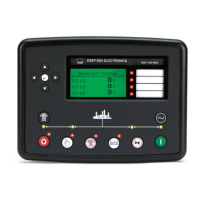Operation
72
6.4 DUMMY LOAD / LOAD SHEDDING CONTROL
This feature may be enabled by the system designer to ensure the loading on the generator is kept to a nominal
amount. If the load is low, ‘dummy loads’ (typically static load banks) can be introduced to ensure the engine is not
too lightly loaded. Conversely as the load increases towards the maximum rating of the set, non-essential loads
can be shed to prevent overload of the generator.
6.2.1 DUMMY LOAD CONTROL
The dummy load control feature (if enabled) allows for a maximum of five dummy load steps.
When the set is first started, all configured Dummy Load Control outputs are de-energised.
Once the generator is placed onto load, the generator loading is monitored by the Dummy Load Control scheme.
If the generator loading falls below the Dummy Load Control Trip setting (kW), the Dummy Load Control Trip
Delay is displayed on the module display. If the generator loading remains at this low level for the duration of the
timer, the first Dummy Load Control output is energised. This is used to energise external circuits to switch in (for
instance) a static load bank.
The generator loading has now been increased by the first dummy load. Again the generator loading is monitored.
This continues until all configured Dummy Load Control outputs are energised.
Should the generator loading rise above the Dummy Load Return level, the Dummy Load Return Delay begins. If
the loading remains at these levels after the completion of the timer, the ‘highest’ active Dummy Load Control
output is de-energised. This continues until all Dummy Load Control outputs have been de-energised.
6.2.2 LOAD SHEDDING CONTROL
The Load Shedding Control feature (if enabled) allows for a maximum of five load shedding steps.
When the generator is about to take load, the configured number of Load Shedding Control Outputs at Startup will
energise. This configurable setting allows (for instance) certain loads to be removed from the generator prior to the
set’s load switch being closed. This can be used to ensure the initial loading of the set is kept to a minimum, below
the Load Acceptance specification of the generating set.
The generator is then placed on load. The Load Shedding Control scheme begins.
When the load reaches the Load Shedding Trip level the Trip Delay timer will start. If the generator loading is still
high when the timer expires, the first Load shedding Control output will energise. When the load has been above
the trip level for the duration of the timer the ‘next’ Load shedding Control output will energise and so on until all
Load Shedding Control outputs are energised.
If at any time the load falls back below the Load Shedding Return level, the Return Time will start. If the load
remains below the return level when the timer has expired the ‘highest’ Load Shedding Control output that has
been energised will be de-energised. This process will continue until all outputs have been de-energised.
When the set enters a stopping sequence for any reason the Load Shedding control’ outputs will de-energise at the
same time as the generator load switch is signalled to open.
NOTE:- Refer to DSE8800 Series Configuration Suite Manual (DSE part 057-164) for further details on
configuration.

